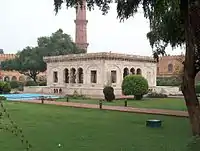Hazuri Bagh Baradari
The Hazuri Bagh Baradari (Urdu: حضوری باغ بارہ دری) is a baradari of white marble located in the Hazuri Bagh of Lahore, Pakistan. It was built by Maharaja Ranjit Singh, the Sikh ruler of Punjab to celebrate his capture of the Koh-i-Noor diamond from Shuja Shah Durrani in 1813. Its construction was completed in 1818.[1][2]
| حضوری باغ بارہ دری | |
 The baradari is in the centre of the Hazuri Bagh quadrangle, and is directly west of the Lahore Fort's Alamgiri Gate | |
 Location in Punjab, Pakistan  Hazuri Bagh Baradari (Pakistan) | |
| Coordinates | 31.5884°N 74.3118°E |
|---|---|
| Location | Lahore, Punjab, Pakistan |
| Type | Baradari |
| Completion date | 1818 |
The pillars support delicate cusped arches. The central area, where Maharaja Ranjit Singh held court, has a mirrored ceiling. The pavilion consisted of two storeys until it was damaged by lightning in 1932.[3]
Images
.jpg.webp) The baradari's basement contains subterranean chambers
The baradari's basement contains subterranean chambers.jpg.webp) Basement of the structure
Basement of the structure The baradari is accessed through archways
The baradari is accessed through archways
 The baradari is in the centre of the Hazuri Bagh quadrangle
The baradari is in the centre of the Hazuri Bagh quadrangle
 East and North sides of the Baradari, Lahore, Pakistan
East and North sides of the Baradari, Lahore, Pakistan Closeup
Closeup Hazuri Bagh Baradari with Lahore Fort, in background.
Hazuri Bagh Baradari with Lahore Fort, in background..jpg.webp) Hazuri Bagh Baradari in 1870, showing the first level pavilion
Hazuri Bagh Baradari in 1870, showing the first level pavilion
References
- Bansal, Bobby (2015). Remnants of the Sikh Empire: Historical Sikh Monuments in India & Pakistan. Hay House, Inc. ISBN 978-9384544935.
- Hazuri Bagh and Baradari, Lahore, Pakistan on Asian Historical Architecture website Retrieved 1 January 2021
- Bhalla, A. S. (2015). Monuments, Power and Poverty in India: From Ashoka to the Raj. I.B.Tauris. ISBN 9781784530877.
External links
| Wikimedia Commons has media related to Hazuri Bagh Baradari. |
This article is issued from Wikipedia. The text is licensed under Creative Commons - Attribution - Sharealike. Additional terms may apply for the media files.